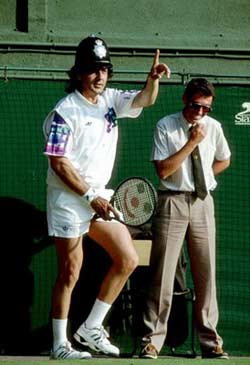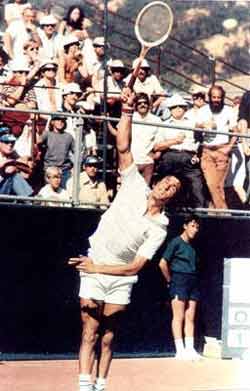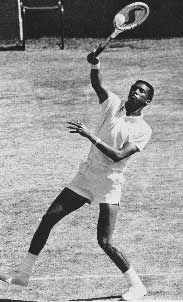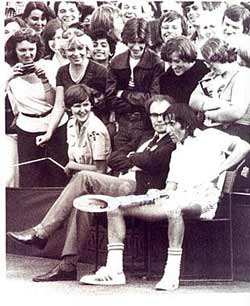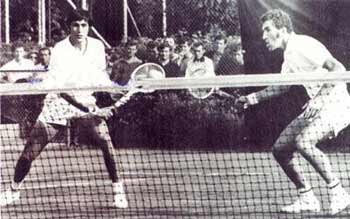<% ns_puts [mkm_getnavbar] %>
SpotLight: Ilie Nastase
By Sean Egan
Today, Ilie Nastase is merely a face that pops up when TV leavens its coverage with comedic clips from bygone days: an image from the age of wooden racquets humorously holding an umbrella on court or taking issue with Cyclops. Few who didn’t see him in action in his heyday or who are not aficionados of tennis history would realize from such footage that Nastase was one of the most breathtakingly gifted players of all time. To some, he was literally the greatest. Yet even those who sing his praises say he underachieved, letting his hot temper and his propensity for buffoonery cheat him of too many titles that were his for the taking. An indication of just how great a player he was is the fact that even in a career of what is universally acknowledged as unfulfilled promise, he claimed championships at the French Open and the US Open as well as an unbelievable four Masters victories.
|
Ilie Nastase was born in Bucharest, Romania in 1946, the youngest of five children. His father started out as a police officer but in time moved over to banking work. In a country then in the grip of communism, young Ilie found refuge from his grim surroundings in sport. He was gifted in several but especially soccer and tennis.
“I have the feeling that every sport I played with a ball, I [had] a very good touch either way,” he says in the endearingly fractured form of English he made familiar at press conferences in the Seventies. “I played basketball, anything. If the sport has a ball, I’m very talented with that.”
Opportunities for practice at tennis were plenty: Nastase’s family lived in a house that was situated in the bounds of a tennis club. Nastase acknowledges that this was a very important factor in his life. “I think it was the basing of becoming a tennis player because I was a ball boy and I was very close to the good players when they play in the club or Davis Cup and I follow all the players everywhere,” he reveals. “I learned quick and that’s what’s for me the preparation to become a good player.”
Though Nastase, of course, had some coaching and practiced hard in his early days, he was one of the few players in history (John McEnroe was another) whose skills were essentially in-born: his instinct, anticipation and quicksilver shot selection were the type of things that simply could not be coached. “It was natural,” he says. “I didn’t have to worry too much what’s coming. I had a lot of intuition for the game. I know ahead what the ball was coming and things like that. I was lucky to have this talent or whatever you call it: gift from God. It’s helpful if you don’t have to practice so hard. For me, everything was natural.” This natural ability meant that Nastase could afford to spurn conventional techniques: “It’s different when you play the way you want and then you see players playing different. For me, it was like, ‘I have to do it my way’. I did it for myself. I pleased myself and if I pleased somebody else, people around the world, even better - but I did it for myself.”
This Gift from God made Nastase a stark contrast to many of his rivals when he became a professional. Asked whether he felt sorry for someone like Bjorn Borg, who was rarely off the practice courts, Nastase says, “No, because it’s a talent that way too. If you ask me to practice five hours, I can’t do that but there are not many players like [me]. The only player I see in the world today I guess like me is Martina Hingis. She knows where to go before the other girls hit the ball. She’s very good intuition. You cannot practice at this.”
|
Despite his natural skill, Nastase didn’t actually start playing on the circuit until he was 21, a very late age even then. He feels this may have handicapped him in a couple of ways. Firstly, it meant he didn’t have as much time to acclimatize to grass as his rivals: “The problem was because I build my tennis on clay,” he laments. “Being brought up on clay, because the courts were so slow. I never had a chance much to play on fast courts.” It wasn’t until he was 21 that Nastase even saw a grass court. The second handicap was the way his backhand - always the weakest shot in his armory - failed to mature: “I developed maybe a wrong shot, that was my backhand. It was difficult for me to go in the big tournaments and improve it quick.” However, another possible explanation for his underachievement was something that couldn’t really be blamed on his late start: his emotionality. “Everything bothered me,” he admits. “If someone was moving in the stadium or the staircase. Some guys like Bjorn never let anything bother them at all.”
When Nastase did start playing on the international circuit, it became clear before very long that here was a new breed. A sport that still dripped with country club connotations - and which for the first few years of his career was still contaminated by the hypocrisy of ‘shamateurism’ - simply wasn’t prepared for Nastase’s kind of character. He argued with umpires in the most profane language imaginable, tormented his opponents with blatant time-wasting and psychological warfare and engaged in silly antics designed to alternately please and alienate the spectators. He was thrown out of tournaments, suspended and fined again and again. All of this produced a rather inevitable nickname: “Nasty”. (“The Bucharest Buffoon” was another favorite insult of his detractors.)
Yet for many, his sublime talent made everything forgivable. He was tennis poetry in motion, gliding around the court with incredible speed and an apparent effortlessness. Equally fast and fluid was his shot-making, switching grips in the blink of an eye to produce exactly the kind of stroke his opponent assumed he couldn’t possibly manage. Charlie Pasarell once marveled, “Sometimes you find him just standing there waiting for the shot.” Topping off those in-born skills was a quality Nastase achieved by the practice normally alien to him: a thunderous first service.
|
Not that it was mere talent that provided Nastase with absolution. That he was a man as warm-hearted and friendly off-court as he was spiteful on court ensured that even the players he tormented found him lovable. The dignified and aloof Arthur Ashe, for instance, was an unlikely friend and remained so even when he stormed out of their match in the 1975 Masters tournament in exasperation at Nastase’s antics.
The mixture of Nastase’s graceful talent and graceless behaviour soon made him the biggest box office attraction the game had hitherto seen and helped attract a younger audience that had previously disdained the sport.
Nastase is unrepentant about his behaviour, despite the widespread feeling that it prevented him fulfilling his potential. (One commentator once described him as “The best player with the worst results of all time”.) “I don’t know,” he shrugs when that issue is put to him. “That’s somebody else’s problem. I only want to be myself and if I look back then, I don’t have any regrets. That’s the way I feel to play the game. Maybe. I don’t know. Maybe if I wasn’t the way I was, then I didn’t win anything. It’s to prove.”
Nastase was also accused of looking down on players whose games weren’t as stylish as his own, even to the point of mocking them by reproducing their own boringly orthodox shots for stretches of matches. Nowadays, a mellower Nastase is almost offended by the suggestion of disdaining the less gifted: “No, no, no,” he insists. “I didn’t do this. Just, maybe the way I was playing, the way I was taking the other man, but no, I never put anybody down or said they are not good players.”
Nastase won his first non-Romanian title in 1967. The first of his two Grand Slam titles came in 1972 when he beat Arthur Ashe in the final of the US Open, astounding even himself by winning a tournament played (then) on grass. The following year, he defeated Nikki Pilic to claim the French Open. (He’d finished runner-up to Jan Kodes in 1971). He should also have won Wimbledon but was always the bridesmaid at the All-England Club. In 1972 he was defeated by American Stan Smith in a stunning final which many still talk about as the greatest ever played there. In 1976, a last hurrah at the age of 30 was only stymied when new young hope Borg beat Nastase to take the trophy.
Nastase’s best tennis, however, was reserved for the Masters. “The last tournament of the year - maybe everybody was tired!” Nastase now suggests in an uncharacteristically modest way. The season-ending tournament which sees the top eight players in the world congregate to determine who is the crème de la crème was an occasion to which Nastase always seemed to rise. He often became bored when taking on lower ranked players (“That was my problem” he admits) but put a superstar in front of him and Nastase suddenly became alert and eager to prove a point. For three years on the trot - 1971 to 1973 - he won the title. In 1974, he was defeated by Guillermo Vilas in the final but came back triumphantly the following year to reclaim the title by trouncing Bjorn Borg losing only five games. Not even Pete Sampras - so dominant in his own era - has been able to best his closest-placed peers so consistently.
|
Of Nastase’s more than one hundred titles, about half were doubles, inevitable for a player with such lightning fast reactions. In mixed, he partnered Rosemary Casals while he had a variety of partners in men’s doubles, the most notable of which was Jimmy Connors, a player with a temperament very similar to his own. “We played for three or four years,” Nastase remembers of his partnership with the pugnacious American. “The time we finished, we’d been defaulted many times. But finally we won two grand slams. Playing with Jimmy was fun. A lot of fun.”
Nastase was the first ever number one in the computer rankings when that system was introduced in 1973, something he is very proud of: “I want to be remembered like a number one. I’m one of the few number ones in the world. For me, it’s a great pleasure to be with all these guys. I think there are twelve or thirteen only, until now.” He feels that the computer rankings were a change that had to be made. “I think the rankings before [’73] was a problem because it was not computer and the sport writers, they make the rankings,” he points out. “Then when the computer came in I thought it was a good system.”
However, he does acknowledge that there is perhaps something unhealthy in the lack of competition to the ATP. In his day, circuits such as World Championship Tennis were alternatives considered equally valid to the main tour. “I think it was okay then,” he recalls. “Many players, they can choose a tour. Now, I don’t know if there is a monopoly, but players, they cannot choose. They have to play ATP. Every single tournament is an ATP tournament. But I think ATP are doing quite a good job. What they’re doing now, they’re trying to cancel some tournaments because obviously there’s a lot of tournaments and, players, they cannot play everywhere and every week.”
Talk of the modern game brings up the subject of players Nastase considers in his own elegant image - or rather, the lack thereof, Hingis excepted. “He’s not playing anymore but a guy from Czechoslovakia - Miloslav Mecir,” Nastase says. “But I don’t know anybody now doing that.” When asked whether he agrees with the perception of many that players today treat the game too much like a business to the detriment of fun, the once outspoken Nastase is surprisingly coy: “I don’t know. I think the game is different, the players are different, and I don’t want to compare with when we played and what we do.” When it’s suggested to him that the game is generally considered less exciting now, he only offers: “I don’t know. I think it’s different and I cannot comment more than that.”
|
Such coyness is a measure of the fact that Nastase - while in no way an establishment figure - has come a long way from the man of scandal of the 1970s. For example, in 1996, he stood as a left-wing candidate for the post of Mayor of Bucharest following his country’s conversion to democracy. Although he didn’t win, he surprised many with his thoughtful campaign. Meanwhile, he was until recently a part-owner - with former doubles partner Ion Tiriac - of the Romanian Open ATP Tour event. “It was different,” he says. “It was something that I had to find many things out. It was a good experience.” However, his part-ownership didn’t entail the former terror of the courts having to endure the embarrassment of disciplining players who misbehaved: “I was not a director of the tournament. I was owning the tournament but I didn’t get that deep, being involved so much. I just put my money in.”
Nastase is still closely involved in tennis development. He is also a fixture on the seniors circuit, where his clowning makes him a crowd favorite. Unfortunately, the partnership between him and Connors has been temporarily shelved: “I’m going into the 55-65 now. Jimmy Connors is a young man. He’s playing in another group with the young players. I’m playing with the grandfathers now.”
Looking back on his career, Nastase says he is happy with his record. Those who talk of him concentrating on indulging himself too much and concentrating on his tennis too little and assume some level of lingering dissatisfaction on his part are barking up the wrong tree. “If you win 57 tournaments and 51 doubles and [four] Masters and I’ve been number one. I’m pleased with my results,” he says. “So I have both. I’m not disappointed with myself.”
To contact us, please email to: webmaster@tennisone.com
TennisONE is a registered trademark of TennisONE and SportsWeb ONE; Copyright 1995. All rights reserved.


